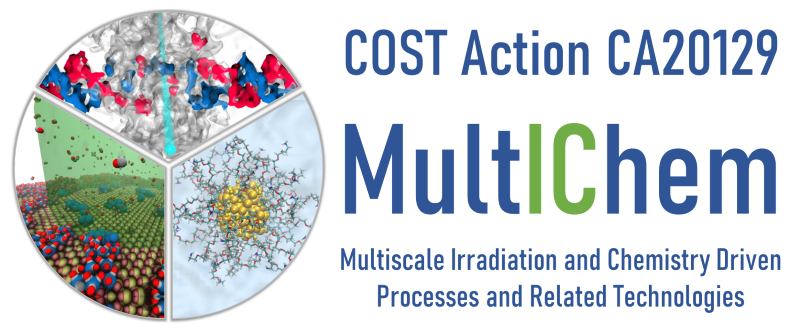Leader: Prof. Ilia Solov'yov
Universität Oldenburg, Institut für Physik (Oldenburg, Germany)
E-mail: ilia.solovyov@uni-oldenburg.de
Objective:
The main objective of WG1 is to acquire a fundamental-level understanding of Irradiation-Driven Chemistry (IDC) transformations of complex molecular systems exposed to different types of radiation. This will be achieved through exploiting atomistic-level theoretical and multiscale computational modelling approaches supported by highly relevant experimental studies.
In order to provide a focus to the Action, research studies will be based around several specific case studies relevant for technological applications, specifically:
- ion irradiation of biomolecular systems (isolated biomolecules such as amino acids, DNA segments, oligonucleotides, etc., and biomolecular clusters, both in the gas phase and in molecular environments);
- electron beam irradiation of deposited metal clusters and nanoparticles;
- electron beam irradiation of organic and inorganic films;
- photon and ion irradiation of metal or metal oxide nanoparticles;
- electron transfer in NP-MOF composites.
- Development of the general multiscale methodology for modelling of the irradiation-induced chemical transformations in molecular systems combining molecular dynamics and Monte Carlo schemes, thus allowing for effective multiscale modelling of the whole spectrum of the processes involved. Development of experimental techniques to benchmark models of IDC in molecular systems. Validation of the model predictions against the results of complementary experiments.
- Exploration of ion irradiation induced chemistry of complex biomolecular systems such as amino acids, oligonucleotides, DNA origami, etc. Exploration of time-resolved fast dynamics of a liquid water environment under exposure to laser-accelerated ion beams. Time-resolved analysis of G-values and the dynamics of different reactive species produced after irradiation of water with ion beams.
- Atomistic-level investigation of electron-driven chemistry in the FEBID process. Study of low-energy electron induced processes in a broad range of organometallic systems taking into account different dissociation mechanisms and their relative contributions at specific electron energies. Incorporation of this knowledge into a multiscale computational model of nanostructure formation and growth under the action of electron beams.
- Investigation of radiation-induced morphology changes as well as impact of the structure and composition of metal-based NPs on their catalytic and radiosensitising properties.
- Data handling and construction of the MultIChem database where a comprehensive databank of IDC-related quantities (e.g., photon, electron and ion interaction cross sections with bio- and organometallic molecules, nanoparticles, nanostructures and composite structures, chemical reaction rates, diffusion coefficients for different atomic and molecular species, compositions of metal-containing nanostructures grown by FEBID, etc.) will be accumulated and archived.
